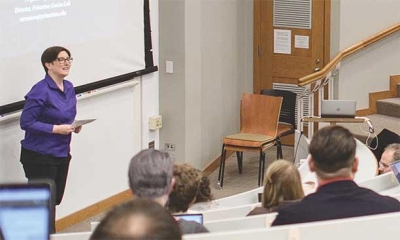September 10, 2019
By Christopher L. Eisgruber ’83 for Princeton Alumni Weekly
When the members of the Class of 1976 matriculated at Princeton in the fall of 1972, the catalogue for their first academic year listed just three “basic courses” for computer science, all of which were in the Department of Electrical Engineering.
Among the members of that class was Eric Schmidt. In the years ahead, Eric would become one of the world’s foremost visionaries and leaders in the world of data science and an extraordinary supporter of his alma mater. But during his undergraduate years at Princeton, Eric pursued his interest in computers by majoring in electrical engineering, “because computer science was barely an option.”
Today, computer science at Princeton is not just an “option”; it is the single largest undergraduate program at Princeton. Approximately 25% of our students either concentrate or earn a certificate in this discipline. More than one in three computer science majors are women, roughly double the national average. About 60% of Princeton undergraduates enroll in COS126, the department’s introductory computer course. The popularity of this class reflects the enormous influence computer science is having on every field of scholarly study.
Computer science has expanded so rapidly over the past decade — a nearly fivefold increase in computer science concentrators by class from 2009 to today — that it is currently spread across more than half a dozen different buildings. This awkward arrangement has accommodated the department’s rapid growth, but it inhibits the vibrant exchanges and scholarly partnerships so essential to intellectual life at Princeton. Fortunately, the spectacular generosity and foresight of Eric Schmidt ’76 and his wife, Wendy Schmidt, will bring the department together again.
The Schmidts’ most recent marvelous gift to Princeton is providing funding to create a purpose-built home for the entire computer science department in a totally transformed Guyot Hall. As Eric said when the gift was announced this spring, “Wendy and I are excited to think about what will be possible when Princeton is able to gather students and faculty in one place, right at the center of campus, to discover nowunimaginable solutions for the future century.”
Eric Schmidt has been in the forefront of the revolution in data science. As chief executive officer of Google from 2001 to 2011, and then as executive chairman of Google’s parent company, Alphabet Inc., the results of his vision and leadership have literally touched the lives of the vast majority of the people of the world and nearly every area of human enterprise. Similarly, his generosity to his alma mater, not only through this gift, but also through the Schmidt Data X Fund and the Schmidt Transformative Technology Fund, is advancing the University’s robust capacity for pathbreaking teaching, innovation and collaboration.
The Schmidt gift will give Guyot Hall a new lease on life. The building has housed environmental science programs for more than one hundred years, but it can no longer support the 21st-century laboratories that they require. The University plans to construct new facilities for the Department of Geosciences, the Department of Ecology and Evolutionary Biology, and the Princeton Environmental Institute.
University Architect Ronald McCoy says, however, that while Guyot Hall is more than a century old, it is surprisingly well-suited for the needs of computer science students and faculty. Its narrow floorplate will allow for generous amounts of daylight in its new classrooms and offices. Additions will support the growth of the department. McCoy sees computer science’s new home in an old building as a contemporary, vibrant, functional space.
Because Guyot’s renovation must wait until the environmental sciences move into their new quarters, construction is not projected to begin until 2024. A modest renovation to the Friend Center will provide the computer science department with additional space contiguous to its current building during the interim period. When the former Guyot Hall is reopened, the improved facility will be named Eric and Wendy Schmidt Hall. The legacy of Arnold Guyot, Princeton’s first professor of geology and geography and the hall’s namesake, will be recognized in a new built space for the environmental science programs elsewhere on campus.

Sameer A. Khan/Fotobudd
As Jennifer Rexford ’91, the Gordon Y.S. Wu Professor of Engineering and chair of the computer science department, recently observed, “Computer science is transforming nearly every human endeavor, and every academic discipline. The field offers tools for converting raw data into knowledge and better decisions, as well as a mode of thought for expressing creative ideas as algorithms for answering a wide range of questions. The central location of historic Guyot Hall places the computer science department at a focal point between all four divisions of the University, enabling closer collaboration and serendipitous encounters for faculty and students alike.”
I am confident that computer science at Princeton will continue to make significant contributions to our ability to understand and manage society’s challenges and opportunities. And, thanks to the generosity and vision of Eric and Wendy Schmidt, Princeton students and faculty will be even better positioned to further the University’s influence on the future for many years to come.